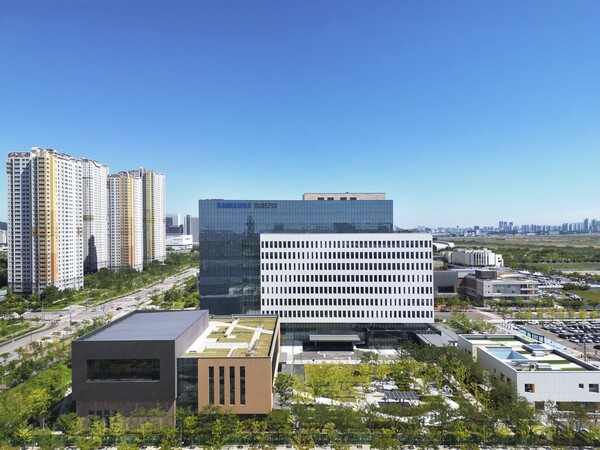Samsung Bioepis just landed Korean approval for Obodence (ingredient: denosumab), its biosimilar to Amgen’s bone blockbuster Prolia, putting it in direct competition with Celltrion, which launched its own denosumab copycat, Stoboclo, last month.
The green light, granted Sunday by the Ministry of Food and Drug Safety, marks the 10th biosimilar in Bioepis’ domestic lineup—and its first foray into the osteoporosis market. It arrives just two months after Samsung Bioepis nabbed back-to-back wins in the U.S. and Europe, where the drug will launch under the names Ospomyv and Obodence, respectively.

Prolia remains a global juggernaut, generating $4.37 billion worldwide in 2024, up 8 percent from the year before. But in Korea, the drug’s trajectory is stalling.
According to newly released UBcare data obtained by Korea Biomedical Review on Monday, Prolia pulled in 185.5 million won ($126,000) in 2024—nearly flat from 181.2 million in 2023 and down sharply from 279.2 million in 2022. Sales reached 71 million won in the first quarter of 2025, a strong early showing on paper—but pricing pressure and new biosimilar launches make that far from certain.
Samsung Bioepis is wasting no time trying to capitalize. Though it hasn’t yet disclosed Obodence’s reimbursement price, the biosimilar is expected to go toe-to-toe with Stoboclo, which debuted at 111,384 won ($75.72)—a 28 percent discount from Prolia’s original 154,700-won price tag.
Celltrion, despite being eligible for a premium under Korea’s “innovative drug” policy, chose to go low. The move signals that both players are bracing for a fight over market share, not margins.
Samsung Bioepis said Obodence will mirror Prolia’s six-month dosing and clinical profile. But the company is also betting on real clinical wins. In head-to-head phase 3 trials, its candidate, SB16, matched Prolia across efficacy, safety, pharmacokinetics, pharmacodynamics, and immunogenicity.
The results supported the biosimilarity of SB16 to denosumab, with secondary endpoints—such as bone mineral density (BMD)—showing comparable outcomes between the two groups.
At the lumbar spine, Obodence increased BMD by 5.6 percent, compared to 5.3 percent for Prolia. At the hip, the gains were 3.5 percent versus 3.2 percent, and at the femoral neck, 2.8 percent versus 2.3 percent.
Nevertheless, Amgen isn’t backing down. A spokesperson for Amgen Korea pointed to the drug’s decade of data, including its 10-year FREEDOM Extension study, which showed a 21.7 percent gain in lumbar spine BMD and a 9.2 percent improvement at the hip—outcomes few competitors can match.
“Prolia’s strength lies in its long-term data and extensive real-world experience,” the spokesperson told Korea Biomedical Review. And after a government-mandated price cut took effect last Thursday, she added, “the price gap between Prolia and biosimilars is no longer expected to be significant.”
The margin may shrink even further. Under Korea’s biosimilar pricing system, Prolia lost 20 percent of its ceiling price the moment a biosimilar entered the market—dropping to 123,760 won. Another cut is due next year, bringing the price closer to the biosimilar floor, or roughly 53.55 percent of the original price—potentially below 100,000 won by 2026.
Ironically, the policy could extend Prolia’s shelf life. With copycats offering only modest discounts, many in the pharma industry say physicians may opt to stick with the incumbent, especially one with long-term data and broad familiarity.
Samsung Bioepis is aiming to change that. Obodence marks the company’s first swing at the osteoporosis market—a departure from its usual focus on immunology and oncology. It’s also doubling down on its domestic footprint, teaming up with Hanmi Pharmaceutical to co-market the drug, in what Bioepis called a “strategic collaboration.”
And it’s not just pricing that could tip the balance. A reimbursement policy shift last May may already be reshaping the market.
The update allows patients to remain on denosumab treatments like Prolia even after their BMD improves beyond a T-score of –2.5, so long as it doesn’t exceed –2.0. That change lets eligible patients stay on the therapy for up to two additional years—potentially delaying switches to generics or other drug classes.
“The updated reimbursement guidelines likely contributed to an uptick in Prolia prescriptions in 2024,” Amgen Korea’s spokesperson said, while cautioning that “various factors influence prescribing trends.”
Those factors now include two powerful Korean biosimilars fighting for relevance in a shrinking pool. Samsung Bioepis has momentum. Celltrion has the head start.
Related articles
- Samsung Bioepis partners with Hanmi for Prolia biosimilar as Celltrion cuts price
- Celltrion's denosumab biosimilar lands in Korea at 28% discount to Prolia
- Celltrion wins FDA nod for Prolia and Xgeva biosimilars
- Celltrion wins EU nod for Prolia, Xgeva biosimilars to treat osteoporosis
- Samsung Bioepis joins denosumab battle with FDA, EU nod as Amgen’s $5.5-bil. stronghold nears patent cliff
- Regeneron shuts out Samsung Bioepis, keeping Eylea biosimilars at bay—for now
- [JPM2025] Celltrion will sell cheap biosimilar for osteoporosis prophylaxis. How will original drug maker Amgen respond?
- Samsung Bioepis launches Soliris biosimilar in US through Teva
- Samsung Bioepis projects $580 mil. in EU cost savings as Stelara biosimilar gains ground
- Doctors slam Korea’s rules on Amgen and Lilly’s bone-forming drugs amid rising fracture risk
- Samsung Bioepis gets Korean nod for biosimilar of Amgen’s bone drug Xgeva
- Samsung Bioepis, Hanmi offer 13% cost savings with new Prolia biosimilar
- Samsung Bioepis hands Amgen's bone drug copycat to Boryung in Korea deal

